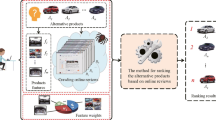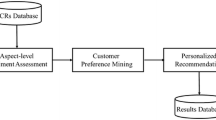Abstract
An increasing number of people use social media to share their consumption experiences. Publicly available online reviews have become a significant source of information, which manufacturers use to better understand customer needs and preferences. To facilitate product improvement, this study first considers the inconsistencies between the numerical product ratings and the textual product reviews to establish the inconsistent ordered choice model (IOCM) for measuring customer preferences with regard to product features. The IOCM model effectively reduces the negative impact of inconsistent reviews on the quality of the customer preference measurement model. On the basis of customer preferences obtained from the IOCM model, we then develop a sentiment-based importance–performance analysis (SIPA) model to analyze the categorization of product features for guiding product development. Compared with the original IPA model, the proposed SIPA model in this paper introduces sentiment-importance into the IPA model that makes the product improvement more adaptive to customer preferences. Finally, we empirically evaluate the effectiveness of our proposed IOCM model and illustrate the utility of our proposed SIPA model.






Similar content being viewed by others
References
Archak N, Ghose A, Ipeirotis PG et al (2011) Deriving the pricing power of product features by mining consumer reviews. Manag Sci 57:1485–1509
Baker KL, Draper J (2013) Importance–performance analysis of the attributes of a cultural festival. J Conv Event Tour 14:104–123
Bi J-W, Liu Y, Fan Z-P, Cambria E (2019a) Modelling customer satisfaction from online reviews using ensemble neural network and effect-based Kano model. Int J Prod Res 57:1–21
Bi J-W, Liu Y, Fan Z-P, Zhang J (2019b) Wisdom of crowds: conducting importance–performance analysis (IPA) through online reviews. Tour Manag 70:460–478
Chen C-C, Chuang M-C (2008) Integrating the Kano model into a robust design approach to enhance customer satisfaction with product design. Int J Prod Econ 114:667–681
Chen Y, Xie J (2008) Online consumer review: word-of-mouth as a new element of marketing communication mix. Manag Sci 54:477–491
Cheung CMK, Lee MKO (2012) What drives consumers to spread electronic word of mouth in online consumer-opinion platforms. Decis Support Syst 53:218–225
Chevalier JA, Mayzlin D (2006) The effect of word of mouth on sales: online book reviews. J Mark Res 43:345–354
Decker R, Trusov M (2010) Estimating aggregate consumer preferences from online product reviews. Int J Res Mark 27:293–307
Eirinaki M, Pisal S, Singh J (2012) Feature-based opinion mining and ranking. J Comput Syst Sci 78:1175–1184
Escobar-Rodríguez T, Bonsón-Fernández R (2017) Analysing online purchase intention in Spain: fashion e-commerce. Inf Syst E Bus Manag 15:599–622
Fink L, Rosenfeld L, Ravid G (2018) Longer online reviews are not necessarily better. Int J Inf Manag 39:30–37
Forman C, Ghose A, Wiesenfeld B (2008) Examining the relationship between reviews and sales: the role of reviewer identity disclosure in electronic markets. Inf Syst Res 19(291–313):393–395
Gensler S, Völckner F, Egger M et al (2015) Listen to your customers: insights into brand image using online consumer-generated product reviews. Int J Electron Commer 20:112–141
Gimpel K, Schneider N, O’Connor B et al (2011) Part-of-speech tagging for twitter: annotation, features, and experiments. In: Proceedings of the 49th annual meeting of the association for computational linguistics: human language technologies: short papers—volume 2. Association for Computational Linguistics, Stroudsburg, PA, USA, pp 42–47
Green PE, Rao VR (1971) Conjoint measurement for quantifying judgmental data. J Mark Res 8:355–363
Halme M, Kallio M (2011) Estimation methods for choice-based conjoint analysis of consumer preferences. Eur J Oper Res 214:160–167
Hatzivassiloglou V, Wiebe JM (2000) Effects of adjective orientation and gradability on sentence subjectivity. In: Proceedings of the 18th conference on computational linguistics—volume 1. Association for Computational Linguistics, Stroudsburg, PA, USA, pp 299–305
He W, Tian X, Hung A et al (2018) Measuring and comparing service quality metrics through social media analytics: a case study. Inf Syst E Bus Manag 16:579–600
Ho Y-C, Wu J, Tan Y (2017) Disconfirmation effect on online rating behavior: a structural model. Inf Syst Res 28:626–642
Hu M, Liu B (2004) Mining and summarizing customer reviews. In: Proceedings of the tenth ACM SIGKDD international conference on knowledge discovery and data mining. ACM, New York, NY, USA, pp 168–177
Huiskonen J, Pirttilä T (1998) Sharpening logistics customer service strategy planning by applying Kano’s quality element classification. Int J Prod Econ 56–57:253–260
Jin J, Ji P, Gu R (2016a) Identifying comparative customer requirements from product online reviews for competitor analysis. Eng Appl Artif Intell 49:61–73
Jin J, Ji P, Kwong CK (2016b) What makes consumers unsatisfied with your products: review analysis at a fine-grained level. Eng Appl Artif Intell 47:38–48
Kwark Y, Chen J, Raghunathan S (2017) User-generated content and competing firms’ product design. Manag Sci 64:4608–4628
Lee TY, BradLow ET (2011) Automated marketing research using online customer reviews. J Mark Res (JMR) 48:881–894
Lee Y-C, Sheu L-C, Tsou Y-G (2008) Quality function deployment implementation based on Fuzzy Kano model: an application in PLM system. Comput Ind Eng 55:48–63
Lee AJT, Yang F-C, Chen C-H et al (2016) Mining perceptual maps from consumer reviews. Decis Support Syst 82:12–25
Li X, Hitt LM (2008) Self-selection and information role of online product reviews. Inf Syst Res 19:456–474
Li Y-M, Chen H-M, Liou J-H, Lin L-F (2014) Creating social intelligence for product portfolio design. Decis Support Syst 66:123–134
Liu J, Liu C, Zhang L, Xu Y (2019) Research on sales information prediction system of e-commerce enterprises based on time series model. Inf Syst E Bus Manag. https://doi.org/10.1007/s10257-019-00399-7
Ma J, Kim HM (2014) Continuous preference trend mining for optimal product design with multiple profit cycles. J Mech Des 136:061002–061002–061002–061014
Marrese-Taylor E, Velásquez JD, Bravo-Marquez F, Matsuo Y (2013) Identifying customer preferences about tourism products using an aspect-based opinion mining approach. Procedia Comput Sci 22:182–191
Martilla JA, James JC (1977) Importance–performance analysis. J Mark 41:77–79
Massa P, Avesani P (2009) Trust Metrics in Recommender Systems. In: Golbeck J (ed) Computing with Social Trust. Springer, London, pp 259–285
McKelvey RD, Zavoina W (1975) A statistical model for the analysis of ordinal level dependent variables. J Math Sociol 4:103–120
Netzer O, Toubia O, Bradlow ET et al (2008) Beyond conjoint analysis: advances in preference measurement. Mark Lett 19:337
O’Neill MA, Palmer A (2004) Importance–performance analysis: a useful tool for directing continuous quality improvement in higher education. Qual Assur Educ 12:39–52
Pavlou PA, Zhang J (2017) On self-selection biases in online product reviews. MIS Q 41:449–471
Qi J, Zhang Z, Jeon S, Zhou Y (2016) Mining customer requirements from online reviews: a product improvement perspective. Inf Manag 53:951–963
Ren J, Yeoh W, Ee MS, Popovič A (2018) Online consumer reviews and sales: examining the chicken-egg relationships. J Assoc Inf Sci Technol 69:449–460
Ringle CM, Sarstedt M (2016) Gain more insight from your PLS-SEM results: the importance–performance map analysis. Ind Manag Data Syst 116:1865–1886
Rosaci D, Sarné GML (2014) REBECCA: a trust-based filtering to improve recommendations for B2C e-commerce. In: Zavoral F, Jung JJ, Badica C (eds) Intelligent distributed computing VII. Springer, Berlin, pp 31–36
Stieglitz S, Mirbabaie M, Ross B, Neuberger C (2018) Social media analytics—challenges in topic discovery, data collection, and data preparation. Int J Inf Manag 39:156–168
Sun M (2012) How does the variance of product ratings matter? Manag Sci 58:696–707
Tan S, Zhang J (2008) An empirical study of sentiment analysis for Chinese documents. Expert Syst Appl 34:2622–2629
Timoshenko A, Hauser J (2019) Identifying customer needs from user-generated content. Mark Sci 38:1–20
Tirunillai S, Tellis GJ (2014) Mining marketing meaning from online chatter: strategic brand analysis of big data using latent Dirichlet allocation. J Mark Res (JMR) 51:463–479
Xiao S, Wei C-P, Dong M (2016) Crowd intelligence: analyzing online product reviews for preference measurement. Inf Manag 53:169–182
Xu Q, Jiao RJ, Yang X et al (2009) An analytical Kano model for customer need analysis. Des Stud 30:87–110
Xu K, Liao SS, Li J, Song Y (2011) Mining comparative opinions from customer reviews for competitive intelligence. Decis Support Syst 50:743–754
Xu X, Wang X, Li Y, Haghighi M (2017) Business intelligence in online customer textual reviews: understanding consumer perceptions and influential factors. Int J Inf Manag 37:673–683
Yang B, Lei Y, Liu J, Li W (2017) Social collaborative filtering by trust. IEEE Trans Pattern Anal Mach Intell 39:1633–1647
Yin D, Bond SD, Zhang H (2014) Anxious or angry? Effects of discrete emotions on the perceived helpfulness of online reviews. MIS Q 38:539–560
Zhang Z, Guo C, Goes P (2013) Product comparison networks for competitive analysis of online word-of-mouth. ACM Trans Manag Inf Syst 3:20:1–20:22
Zhang KZK, Zhao SJ, Cheung CMK, Lee MKO (2014) Examining the influence of online reviews on consumers’ decision-making: a heuristic–systematic model. Decis Support Syst 67:78–89
Zhou F, Jiao RJ, Linsey JS (2015) Latent customer needs elicitation by use case analogical reasoning from sentiment analysis of online product reviews. J Mech Des 137:071401
Acknowledgements
The work is supported by grants from the National Natural Science Foundation of China (No.71501055, and No.71601066).
Author information
Authors and Affiliations
Corresponding author
Additional information
Publisher's Note
Springer Nature remains neutral with regard to jurisdictional claims in published maps and institutional affiliations.
Rights and permissions
About this article
Cite this article
Wang, A., Zhang, Q., Zhao, S. et al. A review-driven customer preference measurement model for product improvement: sentiment-based importance–performance analysis. Inf Syst E-Bus Manage 18, 61–88 (2020). https://doi.org/10.1007/s10257-020-00463-7
Received:
Revised:
Accepted:
Published:
Issue Date:
DOI: https://doi.org/10.1007/s10257-020-00463-7




